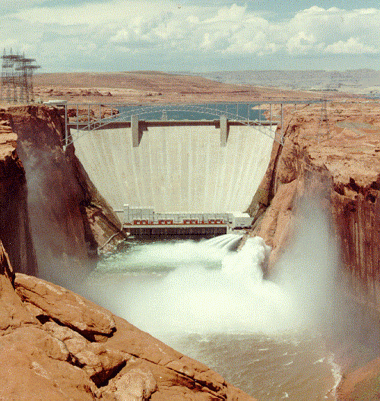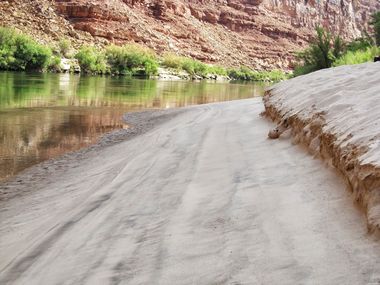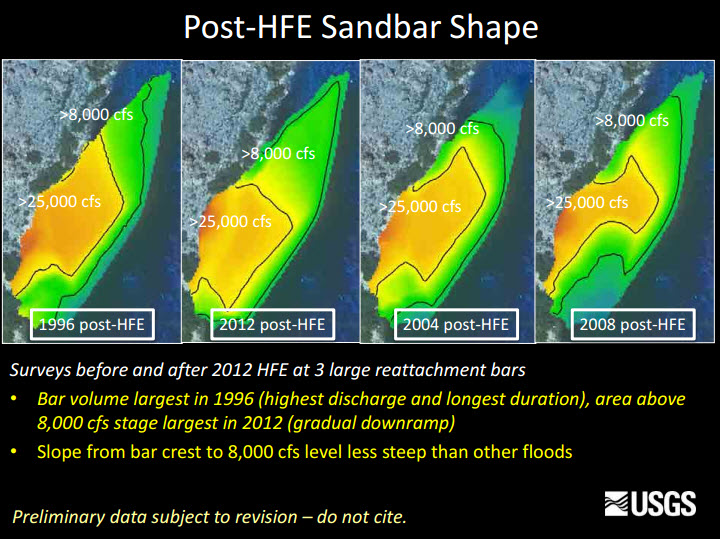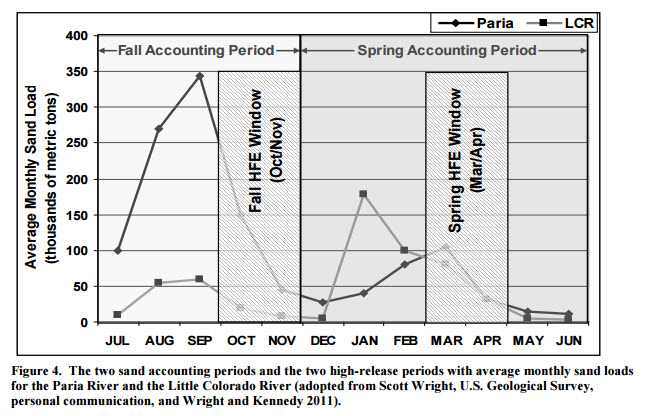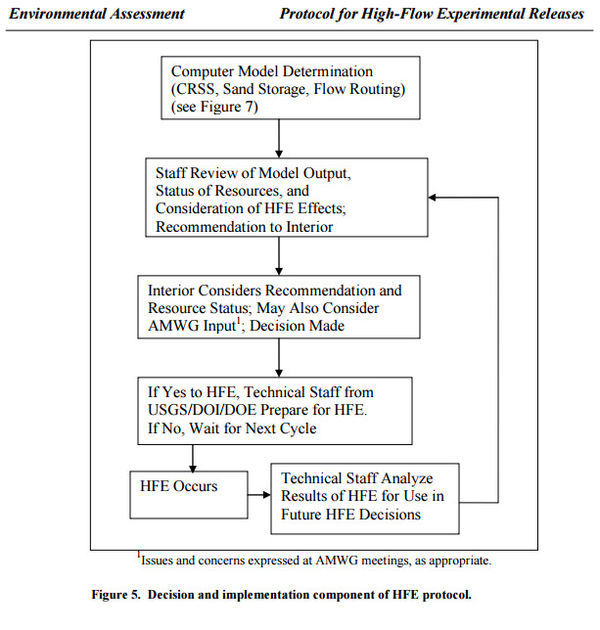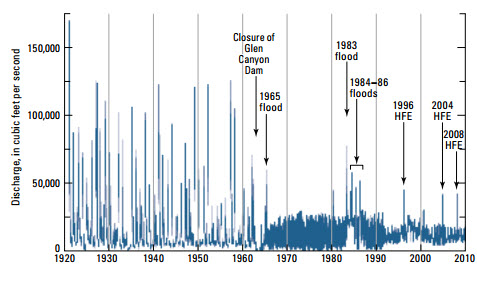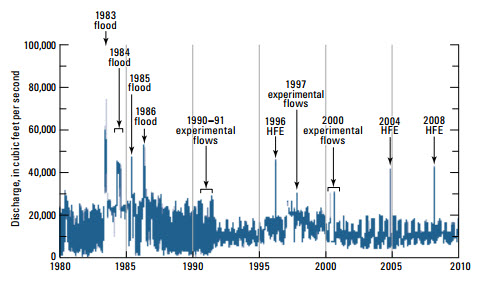Difference between revisions of "The HFE Page"
Cellsworth (Talk | contribs) |
Cellsworth (Talk | contribs) |
||
| Line 70: | Line 70: | ||
*[[Sediment Mass Balance for HFE consideratons- Model explaination| Sediment Mass Balance for HFE considerations- Model explanation]] | *[[Sediment Mass Balance for HFE consideratons- Model explaination| Sediment Mass Balance for HFE considerations- Model explanation]] | ||
*[[GCDAMP Rapid Response Learning Page| Rapid Response HFE Page]] | *[[GCDAMP Rapid Response Learning Page| Rapid Response HFE Page]] | ||
| + | |||
| + | |- | ||
| + | ! <h2 style="margin:0; background:#cedff2; font-size:120%; font-weight:bold; border:1px solid #a3b0bf; text-align:left; color:#000; padding:0.2em 0.4em;">Presentations and Papers </h2> | ||
| + | |- | ||
| + | |style="color:#000;"| | ||
| + | |||
| + | '''2017''' | ||
| + | *[https://www.usbr.gov/uc/rm/amp/twg/mtgs/17jan26/AR3_Grams.pdf Sandbars and Sediment Storage in Marble and Grand Canyons: Response to Recent High-flow Experiments and Long-term Trends PPT] | ||
| + | |||
| + | '''2016''' | ||
| + | *[[Media:Hi Flow Beaches 2016.pdf| The Grand Canyon Private Boater’s Association’s (GCPBA) comments regarding the recently concluded High Flow Experiment releases]] | ||
| + | *[http://www.usbr.gov/uc/rm/amp/amwg/mtgs/16aug24/Attach_11c.pdf Science Behind High Flow Experiment Planning: From Chasing Storms in the Paria River to Serving Data on the Web] | ||
| + | *[http://www.usbr.gov/uc/rm/amp/twg/mtgs/16jan26/documents/Attach_04a.pdf Sand Trigger for High-flow Experimental Protocol] | ||
| + | *[http://www.usbr.gov/uc/rm/amp/twg/mtgs/16jan26/documents/Attach_04b.pdf Introduction of a Motion to TWG Regarding Clarification of the High Flows Protocol for Springtime HFEs: Draft for SCAHG Consideration and Review] | ||
| + | |||
| + | '''2015''' | ||
| + | |||
| + | '''2014''' | ||
| + | *[http://www.usbr.gov/uc/rm/amp/twg/mtgs/14oct28/Attach_13.pdf Modeling Long Term Effects of HFEs on Trout and HBC] | ||
| + | *[http://www.usbr.gov/uc/rm/amp/amwg/mtgs/14aug27/Attach_10.pdf Minute 319/Pulse Flow] | ||
| + | *[http://www.usbr.gov/uc/rm/amp/twg/mtgs/14jan30/Attach_02b.pdf Update on High Flow Experiments Released from Glen Canyon Dam] | ||
| + | |||
| + | '''2013''' | ||
| + | *[http://www.earthmagazine.org/article/releasing-flood-controversy-colorado-river Earth Magazine 2013 Releasing a flood of controversy on the Colorado River] --This article sets the basis for the HFE, provides the history of past HFEs, and discusses the issues. | ||
| + | *[http://www.usbr.gov/uc/rm/amp/twg/mtgs/13nov06/Attach_02b.pdf HFE Protocol Decision Process] | ||
| + | |||
| + | '''2011''' | ||
| + | *[http://pubs.usgs.gov/circ/1366/ Effects of Three High-Flow Experiments on the Colorado River Ecosystem Downstream from Glen Canyon Dam, Arizona] | ||
| + | |||
| + | '''1997''' | ||
| + | *[[Media:1997_GCMRC_WaterTravelTime.pdf| The Colorado River in Grand Canyon: How Fast Does It Flow?]] | ||
| + | |||
| + | '''1996''' | ||
| + | *[http://pubs.usgs.gov/fs/FS-089-96/ Controlled Flooding of the Colorado River in Grand Canyon: The Rationale and Data-Collection Planned] | ||
|- | |- | ||
| Line 107: | Line 141: | ||
*[http://www.usbr.gov/uc/rm/amp/amwg/mtgs/15feb25/Attach_HFE07.pdf Big Flood, Small Flood, Spring Flood, Fall Flood: HFE Timing affects foodbase response in Lees Ferry] | *[http://www.usbr.gov/uc/rm/amp/amwg/mtgs/15feb25/Attach_HFE07.pdf Big Flood, Small Flood, Spring Flood, Fall Flood: HFE Timing affects foodbase response in Lees Ferry] | ||
*[http://www.usbr.gov/uc/rm/amp/amwg/mtgs/15feb25/Attach_HFE08.pdf Native and Nonnative Fishes in Glen, Marble and Grand Canyons] | *[http://www.usbr.gov/uc/rm/amp/amwg/mtgs/15feb25/Attach_HFE08.pdf Native and Nonnative Fishes in Glen, Marble and Grand Canyons] | ||
| − | |||
| − | |||
| − | |||
| − | |||
| − | |||
| − | |||
| − | |||
| − | |||
| − | |||
| − | |||
| − | |||
| − | |||
| − | |||
| − | |||
| − | |||
| − | |||
| − | |||
| − | |||
| − | |||
| − | |||
| − | |||
| − | |||
| − | |||
| − | |||
| − | |||
| − | |||
| − | |||
| − | |||
| − | |||
| − | |||
| − | |||
| − | |||
| − | |||
| − | |||
|- | |- | ||
Revision as of 18:06, 17 February 2017
|
High-Flow Experimental (HFE) ReleasesConstruction and operation of dams results in numerous physical and ecological changes to river systems. Among them is the sediment carrying capacity of the river downstream of the dam. With the construction of Glen Canyon Dam, seasonal flooding that once moved sand from the riverbed to the shoreline, no longer occurs. Because more than 90 percent of the sediment that historically moved through the Grand Canyon is trapped behind the dam, the primary sources of new sand to the river system are two downstream tributaries: the Paria and Little Colorado rivers. The Operation of Glen Canyon Dam Final Environmental Impact Statement, completed in March 1995, hypothesized that controlled high-volume releases of water could be important for restoring ecological integrity downstream from the dam. Testing that hypothesis would help determine whether experimental high flows could be used to benefit important physical and biological resources in Grand Canyon National Park and Glen Canyon National Recreation Area. Such flows would also be consistent with the objectives of the Grand Canyon Protection Act of 1992. Because controlled experimental high-flow releases to some extent mimic natural flooding, conducting such releases would provide the opportunity to evaluate the potential benefit to sediment-dependent resources including sandbars and camping beaches, marsh and riverside vegetation, and backwaters, which are near-shore areas of low-velocity flow which may be used as rearing habitat by native fish. In May 2012, the Department of the Interior implemented a new protocol for conducting multiple high-flow experimental releases through 2020, built on the 16 years of knowledge gained from prior HFEs and associated scientific research and experimentation conducted under the Adaptive management Program. The protocol provides a flexible framework to conduct HFE releases when favorable sediment conditions exist so the optimal timing, duration, frequency, and other conditions that will maximize ecological and riparian benefits downstream in Grand Canyon can be determined. The protocol identifies the conditions under which an HFE release will likely yield the greatest conservation and beneficial use of sediment deposited by inflows from Colorado River tributaries as a result of rainstorms, monsoons, and snowmelt. The ultimate goal of understanding the complexities of the interrelated ecosystem downstream of Glen Canyon Dam is a long-term challenge. The adaptive management model which emphasizes an ongoing cycle of learning through experimentation, refinement, and improvement over time, provides the appropriate framework to achieve this understanding. Through the Glen Canyon Dam Adaptive Management Program, continued implementation of HFEs as a key operational strategy will yield invaluable knowledge about the response of, and benefit to downstream resources. [1] |
| --- | --- | --- |
|---|
|
|
